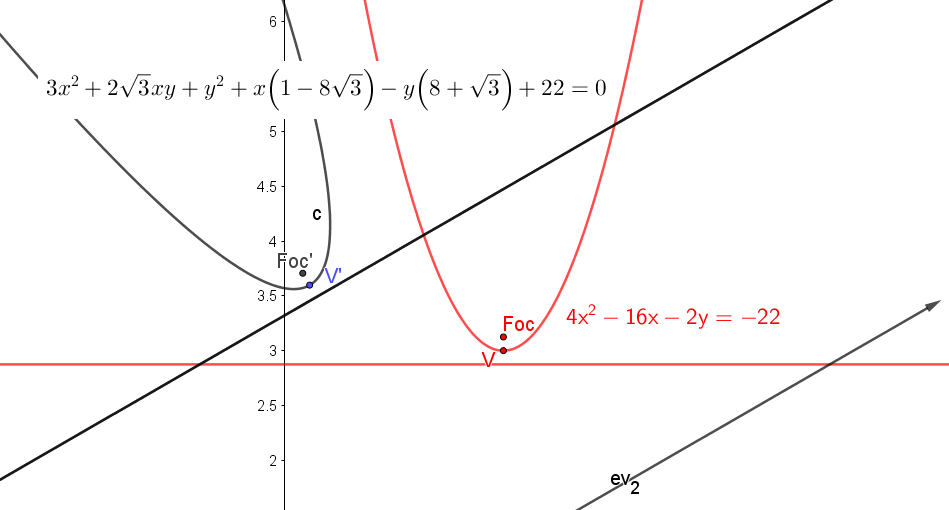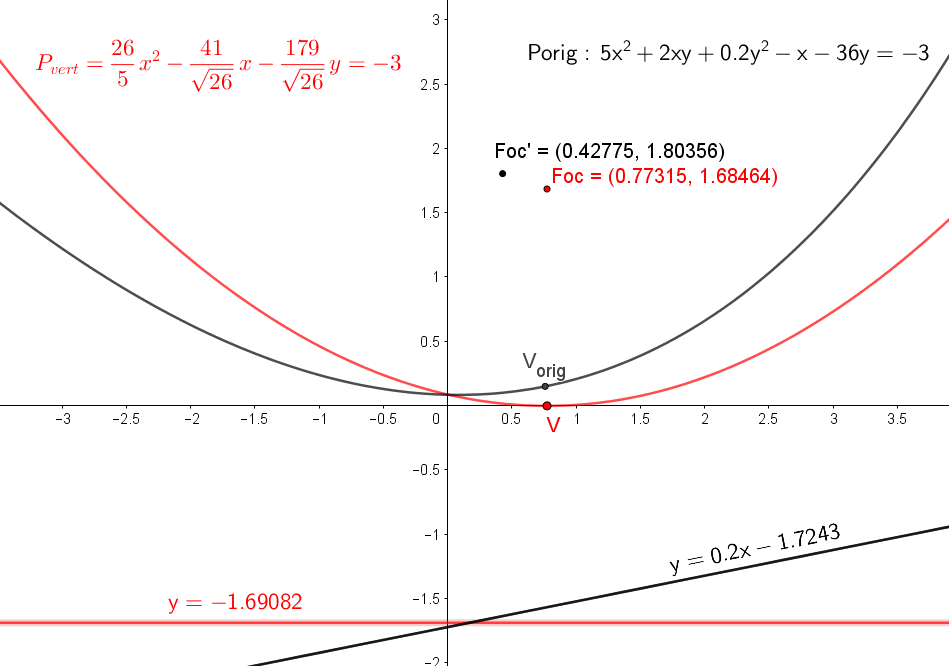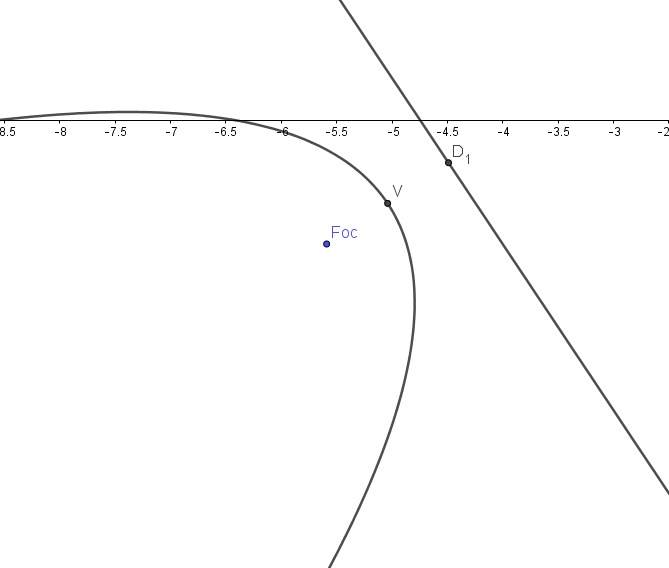Parabola Rotation
A parabola is rotated away from vertical by introducing $xy$ and $y^{2}$ terms into the general equation. There is only one parabola equation. It is $$4p(y-k)=(x-h)^{2}.$$ However, we can substitute a set of axis rotations for $x$ and $y$ and in so doing, we create two new terms in the general equation. The substitutions are $$x=x'\cos\theta+y'\sin\theta$$ $$y=-x'\sin\theta+y'\cos\theta.$$ We might as well account for the $(h,k)$ vertex offset at the same time. That makes the substitution be $$\left(\begin{array}{c} x=(x'-h)\cos\theta+(y'-k)\sin\theta\\ y=-(x'-h)\sin\theta+(y'-k)\cos\theta. \end{array}\right)$$ Now the parabola equation becomes $4p\left[-(x'-h)\sin\theta+(y'-k)\cos\theta\right]=(x'\cos\theta+y'\sin\theta)^{2}$. It is easiest to let the substitutions be their own functions. $$\left(\begin{aligned}a(x,y)= & (x-h)\cos\theta+(y-k)\sin\theta\\ b(x,y)= & -(x-h)\sin\theta+(y-k)\cos\theta \end{aligned} \right)$$ Then the parabola equation is $$4p\left(b(x,y)\right)=\left(a(x,y)\right)^{2}$$
Solving a Rotated Parabola
Given a general form parabola equation, $Ax^{2}+Bxy+Cy^{2}+Dx+Ey+F=0$, we want to find its Focus, Directrix, and Vertex.
Begin with the matrix of Quadratic Form and get the eigenvalues and eigenvectors. Notice that for the parabola, we have replaced $C$ with $B^{2}/(4A)$. It has to be that. The only exception is when the directrix is vertical and the $x^{2}$ term and hence the $A$ coefficient disappears. In that case, it is alread an “aligned” parabola, although aligned sideways. $$Q=\left(\begin{array}{cc} A & B/2\\ B/2 & {\displaystyle \frac{B^{2}}{4A}} \end{array}\right)$$ For the parabola the eigenvalues and eigenvectors are truly easy. $$\left(\begin{array}{c} \lambda_{1}\\ \lambda_{2} \end{array}\right)=\left(\begin{array}{c} 0\\ {\displaystyle \frac{4A^{2}+B^{2}}{4A}} \end{array}\right)$$ $$\mathbf{e}_{1}=\left(\begin{array}{c} -B\\ 2A \end{array}\right)\quad\quad\mathbf{e_{2}}=\left(\begin{array}{c} 2A\\ B \end{array}\right) \tag{1} \label{1}$$ The zero eigenvalue and its vector, $\mathbf{e_{1}}$, match with the major axis, and the other eigenvalue matches with the directrix.
If we choose to rotate the parabola so that it is vertical, then we have a simple quadratic function, which is solved by the method of section Vertical Aligned Vertex Equation or Symbolic Algebra 2.
Rotation
This section shows how to rotate a parabola to be aligned vertically. While we can use $\cot(2\theta)=(A-C)B$ to find the “angle of rotation”, that $\theta$ may result in a rotation to either vertical or horizontal as $-\pi/4\le\theta\le\pi/4$. The method we will show here, will find the directrix angle, $\varphi$ as $-\pi/2\le \varphi \le\pi/2$ and we can rotate to be aligned with the y-axis.
We can get the amount that the parabola is rotated from the directrix eigenvector. Computed as $\mathbf{e_{2}}=\left(\begin{array}{c} 2A\\ B \end{array}\right)$, the eigenvector will always be in either “the first or fourth” quadrant (Case I), or the “second and third” quadrant (Case II) . The value of $\varphi$ in the first case will vary from $-90^{\circ}<\varphi<90^{\circ}$ and in the second case it will vary from $90^{\circ}<\varphi<180^{\circ}$. The difference between the cases is that Case I has a positive coefficient on $x^{2}$ and for Case II it is negative. $$\varphi=atan2(\mathbf{e_{2y}},\mathbf{e_{2x}}).$$ Then we want to rotate the parabola equation by $-\varphi$ to align it with the $y$-axis. The substitution to rotate a Cartesian equation by some angle $\theta$ is $$\text{let }x=x\cos\theta+y\sin\theta$$ $$\text{let }y=-x\sin\theta+y\cos\theta$$ substituted into $Ax^{2}+Bxy+Cy^{2}+Dx+Ey+F=0$. Once aligned, we will have an equation of the form $$ax^{2}+bx+cy+d=0$$ The form was covered in section Symbolic Algebra 2. If it is vertical, then there should be no $xy$ term and no $y^{2}$ term. This can be put into the form $$4p(y-k)=(x-h)^{2}$$ where $(h,k)$ is the vertex and $p$ is the distance from the vertex to the focus as well as the directrix. Although $p$ is a positive distance, it may correctly calculate as a negative number. That is because, depending on the amount of rotation, eigenvector $\mathbf{e_{1}}$ will either point toward the focus or away from the focus. That is, the vertical aligned parabola may be open up or open down. $$F=(h,k+p).$$ To place the focus,$F$, onto the rotated parabola, we have to rotate it counter-clockwise using $\varphi$.
Answer: Let's name the constants. $\left(\begin{array}{ccc} A=3 & B=2\sqrt{3} & C=1\\ D=\left(1-8\sqrt{3}\right) & E=\left(-8-\sqrt{3}\right) & F=22 \end{array}\right)$ Begin by identifying the angle of rotation needed to remove the $xy$ term. There are two ways. First, $\cot(2\theta)=(C-A)/B$. Since $(C-A)\ne 0$, $$\tan(2\theta)=\frac{B}{(C-A)}$$ and $$\theta=\frac{{\displaystyle \tan^{-1}\left(\frac{B}{(C-A)}\right)}}{2}=\frac{1}{2}k\pi-\frac{1}{6}\pi,\text{for k}\in \mathbb{N}$$ The second way is $$\text{directrix vector}=\left(\begin{array}{c} 2A\\ B \end{array}\right)=\left(\begin{array}{c} 6\\ 2\sqrt{3} \end{array}\right)$$ $$\varphi=-atan2\left(2\sqrt{3},6\right)$$ Now do the rotation. Substitute $x'$ and $y'$ terms into the given parabola. Then collect terms, Let, $$\left(\begin{array}{c} x=x'\cos\varphi+y'\sin\varphi\\ y=-x'\sin\varphi+y'\cos\varphi \end{array}\right)$$ $$\begin{aligned} & 3\left(x'\cos\varphi+y'\sin\varphi\right)^{2}\\ + & 2\sqrt{3}\left(x'\cos\varphi+y'\sin\varphi\right)\left(-x'\sin\varphi+y'\cos\varphi\right)\\ + & \left(-x'\sin\varphi+y'\cos\varphi\right)^{2}\\ + & \left(x'\cos\varphi+y'\sin\varphi\right)\left(1-8\sqrt{3}\right)\\ - & \left(-x'\sin\varphi+y'\cos\varphi\right)\left(8+\sqrt{3}\right)\\ + & 22=0 \end{aligned} $$ After collecting terms, we get $$4\left(x'\right)^{2}-16\left(x'\right)-2\left(y'\right)+22=0$$ and we can identify coefficients of this vertical parabola as $$\left(\begin{aligned}a= & 4\\ b= & -16\\ c= & -2\\ d= & 22 \end{aligned} \right)$$ Next use the equation of section Symbolic Algebra 2 to get $h$,$k$,and $p$. $$\left(\begin{aligned}h= & -{\displaystyle \frac{b}{2a}}\\ k= & {\displaystyle \frac{b^{2}-4ad}{4ac}}\\ p= & -{\displaystyle \frac{c}{4a}} \end{aligned} \right)$$ $$\left(\begin{aligned}h= & -{\displaystyle \frac{-16}{2\cdot4}}\\ k= & {\displaystyle \frac{\left(-16\right)^{2}-4\cdot4\cdot22}{4\cdot4\cdot(-2)}}\\ p= & -{\displaystyle \frac{-2}{4\cdot4}} \end{aligned} \right)=\left(\begin{array}{c} h=2\\ k=3\\ p=1/8 \end{array}\right)$$ Next compute the focus and directrix of the vertical parabola. $$V=(h,k)=(2,3)$$ $$Focus=(h,k+p)=\left(2,25/8\right)$$ $$\text{Directrix: }y=k-p=\frac{23}{8}$$ Next rotate the two points. To avoid confusion, in this numeric problem, $\varphi=-\frac{1}{6}\pi$,so $-\varphi=+\frac{1}{6}\pi$ $$Rotate(V,-\varphi)=\left(\begin{array}{c} x=V_{x}\cos(-\varphi)-V_{y}\sin(-\varphi)\\ y=V_{x}\sin(-\varphi)+V_{y}\cos(-\varphi) \end{array}\right)$$

Answer: From equation $\eqref{1}$ we can immediately write the axis vectors. $$\text{major axis direction }\mathbf{ev_{1}}=\left(\begin{array}{c} -1\\ 5 \end{array}\right)$$ $$\text{directrix direction }\mathbf{ev_{2}}=\left(\begin{array}{c} 5\\ 1 \end{array}\right)$$ and the amount to rotate is $$\varphi=-atan2(1,5)=-0.19739556\,rad$$ Setting up the rotation equation: $$\begin{aligned} & 5\;(x\cos\varphi+y\sin\varphi)^{2}\\ & +\frac{1}{5}\;(-x\sin\varphi+y\cos\varphi)^{2}\\ & +2\;(x\cos\varphi+y\sin\varphi)\;(-x\sin\varphi+y\cos\varphi)\\ & -(x\cos\varphi+y\sin\varphi)\\ & -36\;(-x\sin\varphi+y\cos\varphi)=-3 \end{aligned} $$ Which, as expected, reduces to $$\frac{26}{5}\;x^{2}-\frac{41}{26}\;\sqrt{26}\;x-\frac{179}{26}\;\sqrt{26}\;y=-3 \tag{2} \label{2}$$ Putting this into $(x-h)^{2}=4p(y-k)$ by completing the square can be done but is rather tedious and prone to error. Instead, we will use the equations derived in Symbolic Algebra 2.

Solve Without Rotation
Suppose we want to just solve the non-aligned parabola without all this rotation aggravation? We can. It isn't much easier, but we can. Let's begin with a figure.

In figure 3 we have coordinates for points $Foc,P,$ and $Q$ which are all that is needed to apply the definition of a parabola. $$\Vert P-Foc\Vert=\Vert P-Q\Vert \tag{3} \label{3}$$ In the figure, we have defined the coordinates of $P$ as $(x,y)$ but when defining $Q$, we used $P_{x}$ and $P_{y}$. That was just so we could solve for the coordinates of $Q$, but now we will change to let $x=P_{x}$ and $y=P_{y.}$ So $$Q=\left(\frac{x-my-mb}{m^{2+1}},\frac{mx+m^{2}y+b}{m^{2}+1}\right).$$ Now let's apply $\eqref{3}$. $$\sqrt{(x-r)^{2}+(y-s)^{2}}=\sqrt{\left(x-\frac{x-my-mb}{m^{2+1}}\right)^{2}+\left(y-\frac{mx+m^{2}y+b}{m^{2}+1}\right)^{2}} \tag{4} \label{4}$$ So equation $\eqref{4}$ is a parabola equation, but not very pretty. When we use a parabola equation, it is typically to try and find the focus, $Foc(r,s)$ and the directrix, $y=mx+b$. The problem with $\eqref{4}$ is that those values, $m,b,r,s$ were what we started with in the quick derivation. What we will do next is to expand $\eqref{4}$ and look at the coefficients of the parabolic terms, that is, the coefficients of $Ax^{2}+Bxy+Cy^{2}+Dx+Ey+F=0$. After a bit of algebra, the coefficients are $$\begin{aligned}A= & 1\\ B= & 2m\\ C= & m^{2}\\ D= & -2bm-2m^{2}r-2r\\ E= & 2b-2m^{2}s-2s\\ F= & -b^{2}+m^{2}r^{2}+m^{2}s^{2}+r^{2}+s^{2} \end{aligned} $$ These coefficients were all divided by $(m^{2}+1)$ and we multiplied through by that (zero is on the right) to remove it. A minor problem with the set of coefficients is that it requires for $A=1$. To get that form, we must take the general form and divide through by $A$ to make it $1$ and define $B,C,D,E,F$ where each has been divided by $A$. Therefore, the parabola equation will be $$x^{2}+Bxy+Cy^{2}+Dx+Ey+F=0.$$ The slope of the directrix is easily solved from coefficient $B$. Then, coefficients $D,E,$ and $F$ make three equations in the unknowns $b,r,s$. There solution is $$\begin{aligned}b= & \frac{-\left(D^{2}+E^{2}\right)+4F\left(m^{2}+1\right)}{4\left(mD-E\right)}\\ r= & \frac{-D^{2}m+2DE+E^{2}m-4\;Fm^{3}-4Fm}{4Dm^{3}+4Dm-4Em^{2}-4E}\\ s= & \frac{-D^{2}-2DEm+E^{2}+4Fm^{2}+4F}{4Dm^{3}+4Dm-4Em^{2}-4E} \end{aligned} $$
Answer: The way to find the vertex is to get the focus and directrix and find the halfway point of the line in between them. First, we need $m$. $$2m=-3$$ $$m=-3/2$$ Calculate the values for $r,s,$ and $b$. The focus will be $(r,s)$. $$r=\frac{-4\;F\;\left(-\frac{3}{2}\right)^{3}-D^{2}\;\left(-\frac{3}{2}\right)+E^{2}\;\left(-\frac{3}{2}\right)+2\;D\;E-4\;F\;\left(-\frac{3}{2}\right)}{4\;D\;\left(-\frac{3}{2}\right)^{3}-4\;E\;\left(-\frac{3}{2}\right)^{2}+4\;D\;\left(-\frac{3}{2}\right)-4\;E}=\frac{-2253}{403}\approx-5.59$$ $$s=\frac{4\;F\;\left(-\frac{3}{2}\right)^{2}-2\;D\;E\;\left(-\frac{3}{2}\right)-D^{2}+E^{2}+4\;F}{4\;D\;\left(-\frac{3}{2}\right)^{3}-4\;E\;\left(-\frac{3}{2}\right)^{2}+4\;D\;\left(-\frac{3}{2}\right)-4\;E}=\frac{-448}{403}\approx-1.11$$ $$b=\frac{4\;F\;\left(-\frac{3}{2}\right)^{2}-D^{2}-E^{2}+4\;F}{4\;D\;\left(-\frac{3}{2}\right)-4\;E}=\frac{-441}{62}\approx-7.11$$
